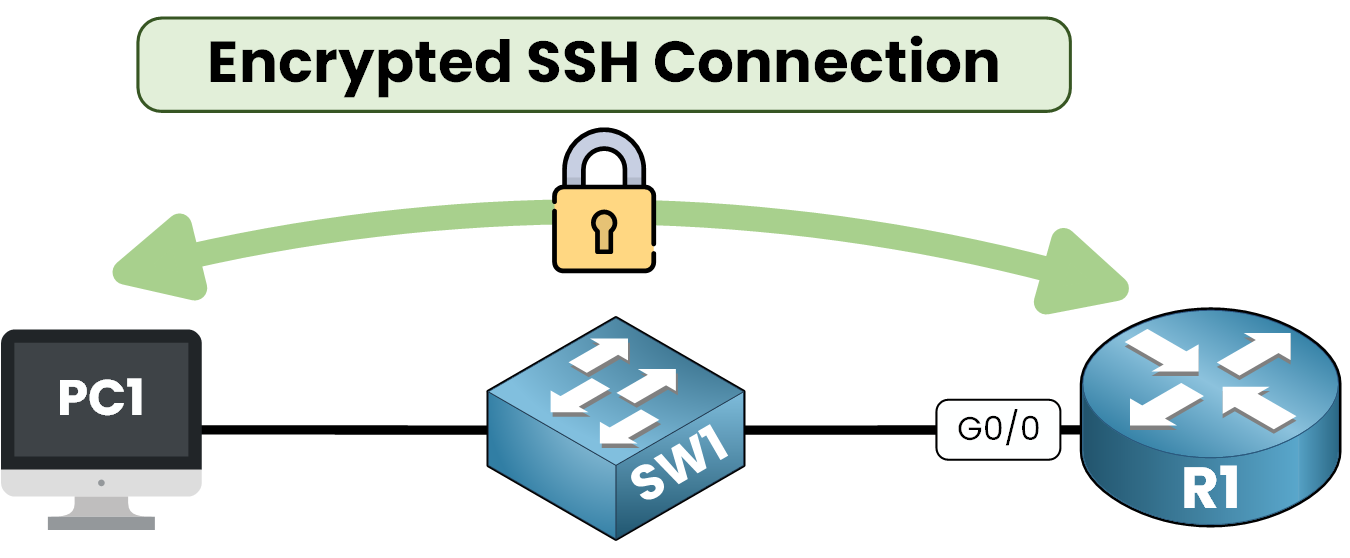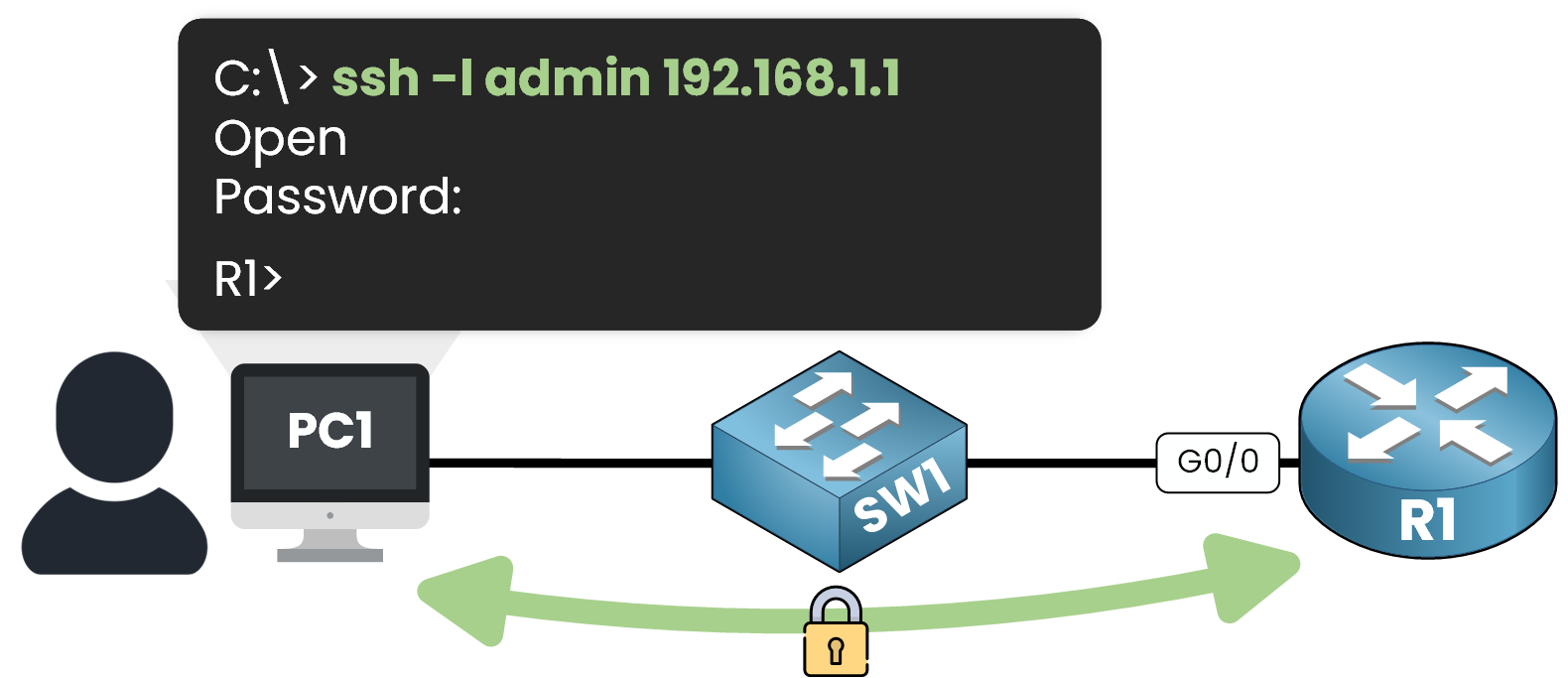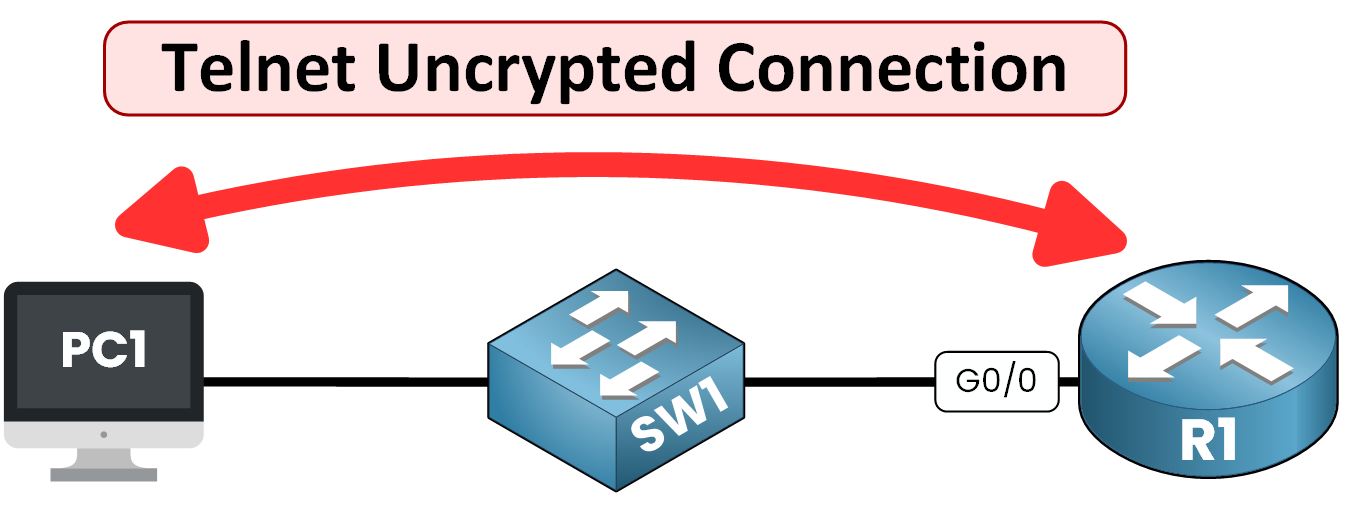Cisco SSH Configuration
Course Contents
1. What is SSH ?
In this course, we’ll look at Cisco SSH Configuration and why it matters for network administrators. Secure Shell (SSH) is a protocol that enables secure remote communication with network devices.
When you work with Cisco routers or switches, knowing how to configure SSH is essential to manage them safely.
Unlike older protocols like Telnet, SSH encrypts all communication to ensure confidentiality and integrity.

Imagine this case, you are a network administrator and you need to configure a interface on your router. SSH ensures that the commands you send are encrypted and protected against unauthorized access.
Benefits of Using SSH
SSH offers several important advantages :
1. Enhanced Security: Encrypted data reduces the risk of traffic interception.
2. User Authentication: Only authorized users can access the device.
3. Remote Device Management: SSH allows secure remote access to Cisco routers and switches.

SSH vs Telnet
SSH is often compared to Telnet, an older remote access protocol.
Here are the key differences:
Encryption:
- SSH: Encrypts all data to prevent eavesdropping
- Telnet: Sends data in plain text, making it vulnerable

Default Ports:
- SSH uses TCP port 22
- Telnet uses TCP port 23
Comparison Table
Here’s a comparison table you can refer to anytime to remember the key differences between SSH and Telnet:
| Feature | SSH | Telnet |
|---|---|---|
| Encryption | ✅ Yes (Encrypted) | ❌ No (plain text) |
| Port | TCP 22 | TCP 23 |
| Use Case | Secure device management | Rarely used |
Now, let’s walk through the steps to prepare and configure SSH on a Cisco device, step by step.
2. How to Configure SSH on a Cisco Devices
To enable SSH on a Cisco device, you need to meet specific requirements and follow a clear configuration process. Everything is covered in this section.

IOS Requirement for SSH
Your Cisco device must run an IOS image that supports cryptographic functions.
Check the IOS version:
Router# show version
Cisco IOS Software, C2900 Software (C2900-UNIVERSALK9-M), Version 15.1(4)M4, RELEASE SOFTWARE (fc2)
Technical Support: http://www.cisco.com/techsupport
Copyright (c) 1986-2012 by Cisco Systems, Inc.
Compiled Thurs 5-Jan-12 15:41 by pt_team
// OUTPUT OMITTED
Look for a k in the image name (universalk9).
If it’s not present, SSH cannot be enabled on the device.
Step 1 – Set the Hostname and Domain Name
Both the hostname and domain name are required to generate RSA keys.
Router> enable
Router# configure terminal
Enter configuration commands, one per line. End with CNTL/Z.
Router(config)# hostname R1
R1(config)# ip domain-name pingmynetwork.com
Step 2 – Generate RSA Key Pair
Generate the cryptographic keys used by SSH.
R1(config)# crypto key generate rsa The name for the keys will be: R1.pingmynetwork.com Choose the size of the key modulus in the range of 360 to 4096 for your General Purpose Keys. Choosing a key modulus greater than 512 may take a few minutes. How many bits in the modulus [512]: 2048 % Generating 2048 bit RSA keys, keys will be non-exportable...[OK]
Recommended modulus size: 1024 or 2048 bits (minimum 768).
Step 3 – Create a Local User for SSH Login
SSH requires a local user account to authenticate the connection. This account will be used as the username and password when connecting via SSH.
R1(config)# username admin secret pingmynetwork1
This command creates a user named admin with the secret password pingmynetwork1.
When the client connects using SSH, this is the account that will be used for login.
C:> ssh -l admin 192.168.1.1
Password:
Step 4 – Set the Enable Secret for Privileged Mode
After logging in via SSH, the user will be placed in user EXEC mode (R1>).
To access privileged EXEC mode (R1#), the user must type enable, and the router will prompt for the enable password.
R1(config)# enable secret cisco
This command sets the password required to enter privileged EXEC mode.
R1> enable Password: R1#
If this step is skipped, the router will deny access to privileged mode and display the message:
% No password set.
Step 5 – Configure VTY Lines for SSH Only
Configure the virtual terminal (VTY) lines to accept SSH connections and require local user authentication.
R1(config)# line vty 0 15 R1(config-line)# transport input ssh R1(config-line)# login local R1(config-line)# exit
This disables Telnet and ensures that only SSH connections are accepted using the local user database.
Step 6 – Enable SSH Version 2 (Recommended)
Enable SSH version 2, which provides better security than version 1.
R1(config)# ip ssh version 2
R1(config)# end
Step 7 – Assign an IP Address to Access the Device
SSH requires that the router has an active IP address on an interface.
R1(config)# interface GigabitEthernet0/0 R1(config-if)# ip address 192.168.1.1 255.255.255.0 R1(config-if)# no shutdown %LINK-5-CHANGED: Interface GigabitEthernet0/0, changed state to up %LINEPROTO-5-UPDOWN: Line protocol on Interface GigabitEthernet0/0, changed state to up
At this point, SSH is fully operational. You can now connect to the router from a client using the IP address 192.168.1.1 and the user account admin.
3. Verifying SSH Access
Once SSH is configured on the router, the next step is to test the connection from a client machine to ensure that everything is working correctly.
Test SSH Access From the Client
From the PC, start by testing connectivity to the router’s IP address using the ping command:
C:\> ping 192.168.1.1
Pinging 192.168.1.1 with 32 bytes of data:
Reply from 192.168.1.1: bytes=32 time=5ms TTL=128
Reply from 192.168.1.1: bytes=32 time=6ms TTL=128
Ping statistics for 192.168.1.1:
Packets: Sent = 2, Received = 2, Lost = 0 (0% loss)
Approximate round trip times in milli-seconds:
Minimum = 5ms, Maximum = 6ms, Average = 5ms
If the router responds, SSH connection can proceed.
SSH Login from PC1
Initiate an SSH session from the client:
C:\>ssh -l admin 192.168.1.1 Password:
Once authenticated:
R1> enable Password: R1#
You are now connected to the router securely via SSH and have full privileged access.
Restrict SSH Access With an ACL (Optional)
To improve security, you can restrict SSH access to specific IP addresses or subnets.
Create the ACL
To allow only one trusted host:
R1(config)# access-list 1 permit host 192.168.1.10
Apply the ACL to the VTY lines
R1(config)# line vty 0 15 R1(config-line)# access-class 1 in
4. Summary
SSH provides a secure and reliable way to manage Cisco devices remotely. Unlike Telnet, SSH encrypts all communication, protecting sensitive commands and credentials from being exposed.
In this lesson, you learned how to:
- Verify IOS compatibility for SSH support
- Prepare the device by setting a hostname and domain name
- Generate RSA keys for encryption
- Create a local user for authentication
- Secure remote access by enforcing SSH-only connections and applying an access list
- Protect privileged mode with an enable secret
Recommended Configuration
hostname R1 ip domain-name pingmynetwork.com crypto key generate rsa 768 enable secret cisco username ping secret pingmynetwork line vty 0 15 transport input ssh login local access-class 1 in exit ip ssh version 2 access-list 1 permit host 192.168.1.10
Key Security Measures:
- SSH only:
transport input sshdisables Telnet by allowing only SSH. - Authentication: Access is restricted to the local user
ping. - Authorization: Only the IP
192.168.1.10is allowed to connect via SSH. - Encryption: Communication is secured with RSA key pairs and SSH version 2.
With this setup, your Cisco router is protected against unauthorized access while enabling secure remote management exactly what you need as a network administrator.
